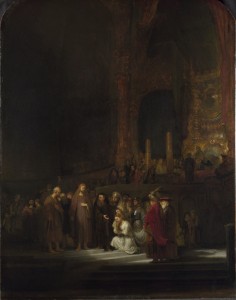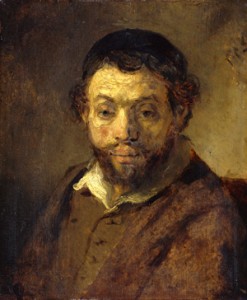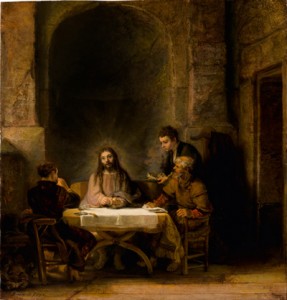Issue Archive
The Arts: Rembrandt and the Jews

When you enter the Philadelphia Museum of Art’s “Rembrandt and the Face of Jesus” it may not be immediately apparent what the exhibition’s connection is to Jewish history, or to the relationships the greatest painter, draftsman and printmaker of the Dutch Golden Age had with the Jews of Amsterdam.
The focal point of the exhibition—which contains 22 paintings, 17 drawings and 9 prints by the master and his studio—is the radical way Jesus is portrayed, both artistically and philosophically, by the artist in his midcareer. (Seven of the pieces, portraits of Jesus, are being shown together for the first time since they were painted, between 1648 and 1656.) The remarkable break from artistic tradition is the emphasis Rembrandt placed on his subject’s humanity and ethnicity—using models and details taken from his neighbors.
Not only did Rembrandt van Rijn live for years in the Jewish quarter of Amsterdam, known for its multiculturalism and tolerance, he also befriended Menasseh Ben Israel, a Jewish community leader and one of the artist’s patrons. Rembrandt might also have known the philosopher Baruch Spinoza who, as is indicated on a map of the area in the exhibition, lived close by.
There are hints, even in the exhibition opening, of the impact Rembrandt’s interaction with his Jewish neighbors had on his work. Even before that change had fully taken root, a painting from 1644, Christ and the Woman Taken in Adultery (oil on panel), is nonetheless not entirely conventional in its representation of Jesus. Rembrandt conveys the empathy Jesus feels for the accused sinner brought before him for judgment. At the same time, Jesus remains a heroic figure—tall, light-haired, with a superhuman physique. This was in keeping with the tradition that had held sway for a millennium, portraying Jesus as the most beautiful of mortals and with a radiating light. Some of the sources of this tradition are explored in the exhibition through the story of the Veil of Veronica—supposed to contain an exact image of Jesus—and the Lentulus Letter, which describes him in detail.
Further, noted exhibit curator Lloyd De Witt, Christ and the Woman Taken in Adultery deviates in the portrayal of the Temple. Apparently the artist used Josephus as a source. In addition to the Tanakh and Christian Bible, Rembrandt was familiar with and drew upon the works of the Jewish historian and on the Apocrypha.

Another early work, Christ at Emmaus (1634, etching on paper) depicts the same type of powerfully built man with emanations of light. But later Rembrandt adapted a more humane and less-idealized approach—and, most notably, one with dark hair and gaunt features who might be considered “Semitic.”
The exhibition zeroes in on the Jewish community of Amsterdam. Rembrandt used Jews as models for his sketches and paintings. One noteworthy example isPortrait of a Young Jew (oil on panel). In the painting, bold dabs of paint give a rugged and expressive texture to the subject’s otherwise youthful face. His skullcap, according to the exhibition notes, was not distinctively Jewish, but rather common headgear of Dutch scholars at the time.
Even more striking is the subject of the Portrait of a Young Jew in Profile (oil on panel), who also appears to be the model for several of the Head of Christpaintings. Painted on wood, the series of heads may mark the first time in the history of art that a live model rather than a canonical concept was used to portray Jesus.
No one knows who the Jewish model was, though he was probably Sefardic. But especially in the Head of Christ created between 1648 and 1656 (oil on oak panel), his gaze is direct and piercing—not ethereal. In another departure from tradition, Rembrandt painted Jesus several times as single figures rather than in relationship to other individuals or crowds. He is represented in close-up, half-length and portrait-like poses—often contemplative or even spiritually troubled, rather than supremely confident. One example is Christ with Arms Folded (oil on canvas).

Further acknowledgment of Jesus’ Jewishness (and humanity) is given by the artist in Supper at Emmaus (1648, oil on mahogany panel). The loaf of bread Jesus is eating is a braided halla—a fact Rembrandt is likely to have known from his Jewish neighbors. This is a story he returned to many times—of two disciples who meet Jesus on the road and later dine with him, but fail at first to recognize him. It can be imagined that the people of Rembrandt’s time did not, at first glance, recognize Jesus in the dark-haired young Jew who modeled for the artist and ultimately changed perceptions.
“Rembrandt and the Face of Jesus” continues through October 30 at the Philadelphia Museum of Art (215-763-8100; www.philamuseum.org). Several public programs accompany the exhibition, including two cosponsored by the National Museum of American Jewish History. The first, on September 25, will address Interfaith Dialogue in Amsterdam, and the second, on October 9, will focus on The Sephardic Community at the Time of Rembrandt.









 Facebook
Facebook Instagram
Instagram Twitter
Twitter
Jasper Deane MA RCA says
The ‘portrait of a young Jew’ bears a strong resemblance to the ‘Portrait of Menasseh Ben Israel’ by Rembrandt-particularly the etching. Menasseh ben Israel lived near Rembrandt and was a good friend who advised him on the Hebrew lettering in his painting of ‘Nebucanezer’s Feast’. It is recorded that Rembrandt painted him. The contemporary Artist and one time student of mine, Marion Monas, is a living relation of the great man.
JD
Michel Didier says
In 2006, the Jewish Historical Museum in Amsterdam committed an exhibition to ‘The Jewish Rembrandt’, which denounced ALL references to jewishness in Rembrandt’s work as false or unproven, save one the portrait of the physician Ephraim Bueno. So, even the famous portraits of Menasseh ben Israel do not even resemble the famous intellectual. So there you go.